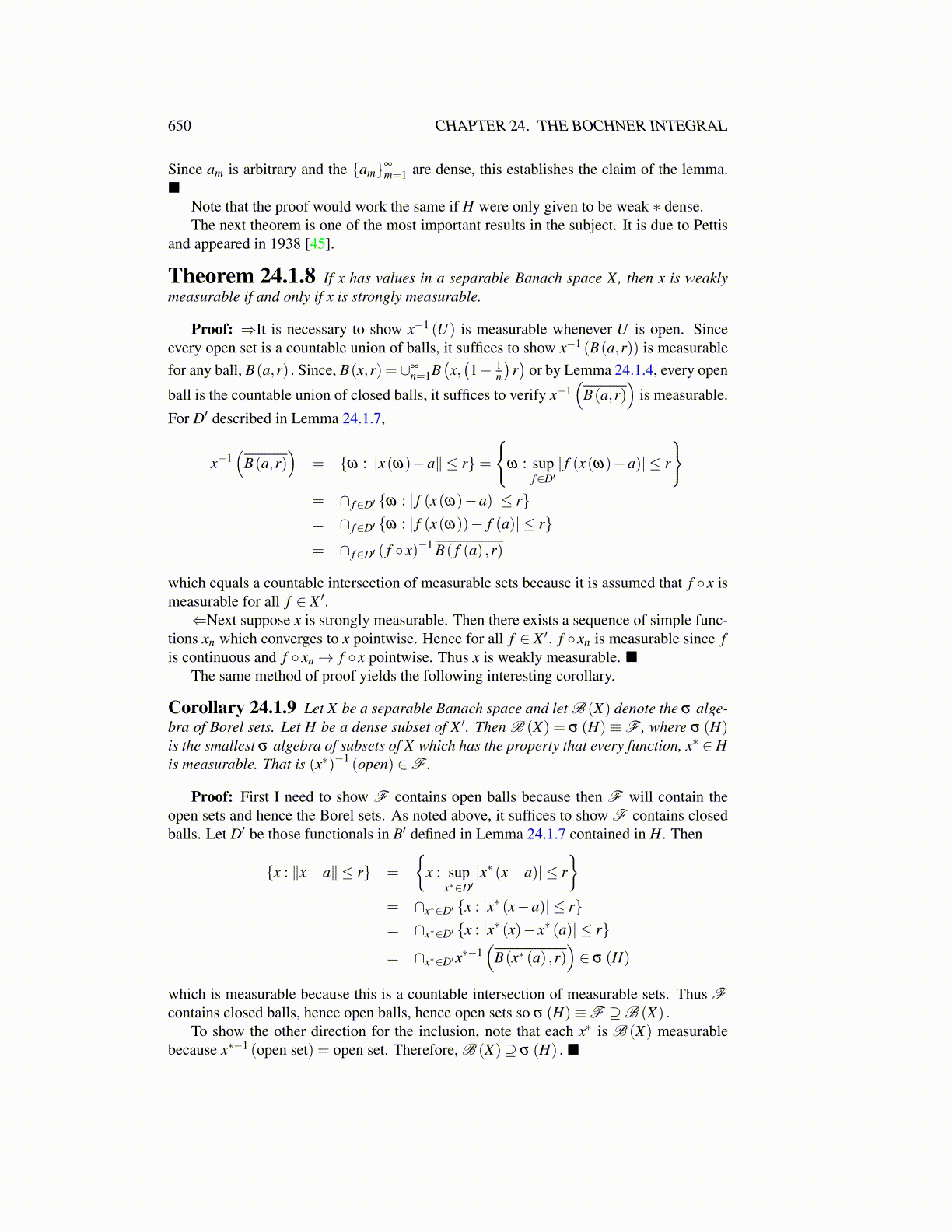
650 CHAPTER 24. THE BOCHNER INTEGRAL
Since am is arbitrary and the {am}∞
m=1 are dense, this establishes the claim of the lemma.■
Note that the proof would work the same if H were only given to be weak ∗ dense.The next theorem is one of the most important results in the subject. It is due to Pettis
and appeared in 1938 [45].
Theorem 24.1.8 If x has values in a separable Banach space X, then x is weaklymeasurable if and only if x is strongly measurable.
Proof: ⇒It is necessary to show x−1 (U) is measurable whenever U is open. Sinceevery open set is a countable union of balls, it suffices to show x−1 (B(a,r)) is measurablefor any ball, B(a,r) . Since, B(x,r) =∪∞
n=1B(x,(1− 1
n
)r)
or by Lemma 24.1.4, every open
ball is the countable union of closed balls, it suffices to verify x−1(
B(a,r))
is measurable.
For D′ described in Lemma 24.1.7,
x−1(
B(a,r))
= {ω : ∥x(ω)−a∥ ≤ r}=
{ω : sup
f∈D′| f (x(ω)−a)| ≤ r
}= ∩ f∈D′ {ω : | f (x(ω)−a)| ≤ r}= ∩ f∈D′ {ω : | f (x(ω))− f (a)| ≤ r}
= ∩ f∈D′ ( f ◦ x)−1 B( f (a) ,r)
which equals a countable intersection of measurable sets because it is assumed that f ◦ x ismeasurable for all f ∈ X ′.⇐Next suppose x is strongly measurable. Then there exists a sequence of simple func-
tions xn which converges to x pointwise. Hence for all f ∈ X ′, f ◦ xn is measurable since fis continuous and f ◦ xn→ f ◦ x pointwise. Thus x is weakly measurable. ■
The same method of proof yields the following interesting corollary.
Corollary 24.1.9 Let X be a separable Banach space and let B (X) denote the σ alge-bra of Borel sets. Let H be a dense subset of X ′. Then B (X) = σ (H)≡F , where σ (H)is the smallest σ algebra of subsets of X which has the property that every function, x∗ ∈His measurable. That is (x∗)−1 (open) ∈F .
Proof: First I need to show F contains open balls because then F will contain theopen sets and hence the Borel sets. As noted above, it suffices to show F contains closedballs. Let D′ be those functionals in B′ defined in Lemma 24.1.7 contained in H. Then
{x : ∥x−a∥ ≤ r} =
{x : sup
x∗∈D′|x∗ (x−a)| ≤ r
}= ∩x∗∈D′ {x : |x∗ (x−a)| ≤ r}= ∩x∗∈D′ {x : |x∗ (x)− x∗ (a)| ≤ r}
= ∩x∗∈D′x∗−1(
B(x∗ (a) ,r))∈ σ (H)
which is measurable because this is a countable intersection of measurable sets. Thus Fcontains closed balls, hence open balls, hence open sets so σ (H)≡F ⊇B (X) .
To show the other direction for the inclusion, note that each x∗ is B (X) measurablebecause x∗−1 (open set) = open set. Therefore, B (X)⊇ σ (H) . ■